"Blood on the sleeve"
In the Soviet Union, his name was a legend. Throughout the country, schoolchildren in class learned a song about how “the regiment commander walked under a red banner, his head was wounded, blood was on his sleeve ...” She is about Schors, the celebrated hero of the Civil War. Or, to put it in modern language, the field commander who fought on the side of the Bolsheviks.
Under the Democrats, attitudes toward Shchors changed. The current students about him almost did not hear anything. And those who are older know that the “red division commander” was a Ukrainian from Snovsk (now the city of Shchors of the Chernihiv region). After the outbreak of the First World War, he underwent an accelerated officer course and, with the rank of ensign, he went to the South-Western Front. He served as a second lieutenant.
After the establishment of Soviet power, Shchors became commander of the First Red Ukrainian Regiment. In January, the regiment occupied 1919 Kiev, where Shchors became commandant. The city was a bloody terror. Every day, drunk security officers shot hundreds of people. Shchors himself didn’t like executions, but he often indulged in vodka (it was said that cocaine also — although the White Guard “hit” with cocaine more).
It is difficult to judge his commanding talents: in the first major confrontation with the regular Denikin army, Shchors was defeated, and he died in October 1919 at the Beloshnitsa station. He was twenty-four years old.
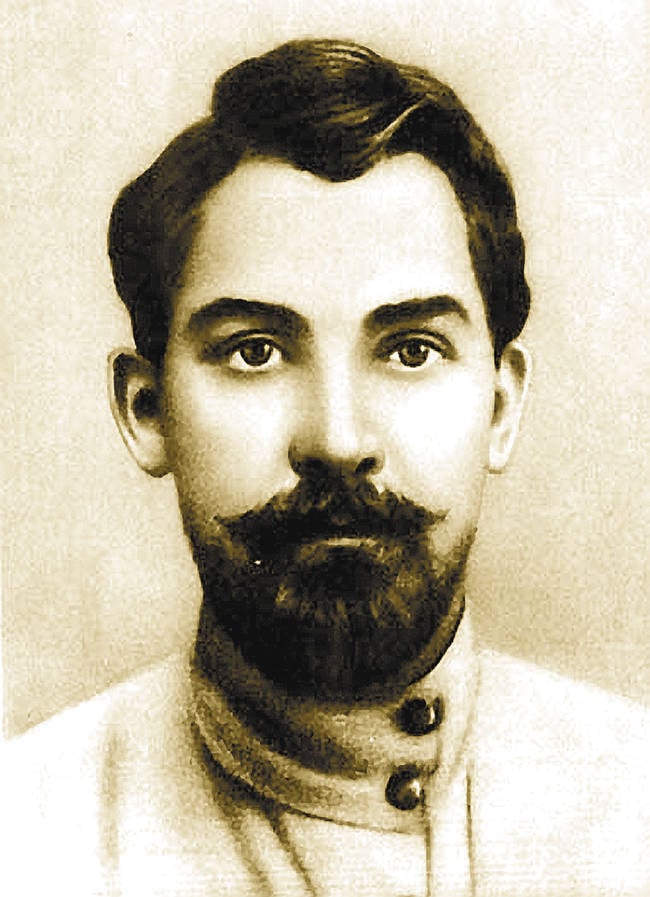
On the same days, another legendary paint died in the Urals - Vasily Chapaev, who survived Shchors for five days. He became more famous - rather because the film “Chapaev” with the brilliant Boris Babochkin came out earlier and was more talented than the film “Shchors”.
This, in sum, is a short and fragmentary assessment of the personality of Nikolai Shchors, drawn from Moscow editions.
SHOT IN THE CELL
I learned about the fate of Shchors from his maternal grandson, Alexander Alekseevich Drozdov. He had a solid journalistic experience, the rank of lieutenant colonel and twenty-one years of service in the KGB. Eight of them spent in Tokyo, combining the work of a journalist under the roof of a Komsomolskaya Pravda correspondent and an employee of Soviet intelligence. Then he returned home, worked in 1988-1990-ies as the editor-in-chief of Komsomolskaya Pravda, and then headed the newspaper of the Russian parliament, the weekly Rossiya.
Once, when we were on a business trip in Kiev, Drozdov began to talk about Shchors and some family legends, and already in Moscow he showed materials on this topic. So in my mind, the image of the “Ukrainian Chapaev” (Stalin's definition) received a new interpretation.
... Nikolai Shchors was buried in the Orthodox All-Saints cemetery in Samara - away from Ukraine. Prior to this, the body without an autopsy and medical examination was forwarded to Korosten, and from there the mourning train to Klintsy, where a farewell ceremony was held for relatives and fellow officers from the beginning.
To the place of the last resting place Shchors was carried by a freight train in a zinc coffin. Before, in Klintsy, the body was embalmed. Doctors put it in a steep solution of salt. Bury in the night, in a hurry. In fact - secretly, avoiding publicity.
Shchors' civil wife, a member of the Cheka, Fruma Khaikina, wrote in 1935: “... The fighters, like children, cried at his grave. These were hard times for the young Soviet republic. The enemy, who felt the near death, made the last desperate efforts. Brutalized gangs cruelly dealt not only with the living fighters, but also mocked the corpses of the dead. We could not leave Shchors for the abuse of the enemy ... The political department of the army forbade the bury of Shchors in threatened areas. With the coffin of a friend, we drove north. The body, placed in a zinc coffin, was permanent honor guard. We decided to bury him in Samara ”(“ The Legendary Primer ”compilation, 1935 year).
The reason that the command went to such measures, became known only in the 1949 year after the exhumation of the body. Thirty years have passed since the death of Shchors. The surviving veterans sent a letter to Moscow in which they resented the disappearance of the commander’s grave. The authorities of Kuybyshev got a scolding, and in order to smooth the blame, they immediately set up a commission, which proceeded to work.
The first attempt to find the burial of Shchors was made in the spring of 1936, the excavations were carried out by the NKVD Office during the month. The second attempt took place in May 1939-th, but it also proved to be ineffective.
The place where the grave was located was indicated by a random witness for the funeral, a citizen of Ferapontov. In 1919, still a homeless boy, he helped the cemetery watchman. Thirty years later, on May 5, he led members of the commission to the territory of the cable plant and there, querying for a long time, indicated an approximate square where searches should be conducted. As it turned out, Shchors' grave was covered with a half-meter layer of rubble.
The commission found that "on the territory of the Kuibyshev cable plant (former Orthodox cemetery), in 3 meters from the right corner of the western facade of the electrical department, a grave was found, in which N.Schors body was buried in September 1919".
10 July 1949, the coffin with the remains of Shchors was transferred to the main alley of the Kuibyshev cemetery, a few years later a granite monument was erected on the grave, to which wreaths and flowers were laid on the red calendar days. Pioneers and Komsomol members came here who did not suspect that the truth about his death was buried along with the remains of Shchors.
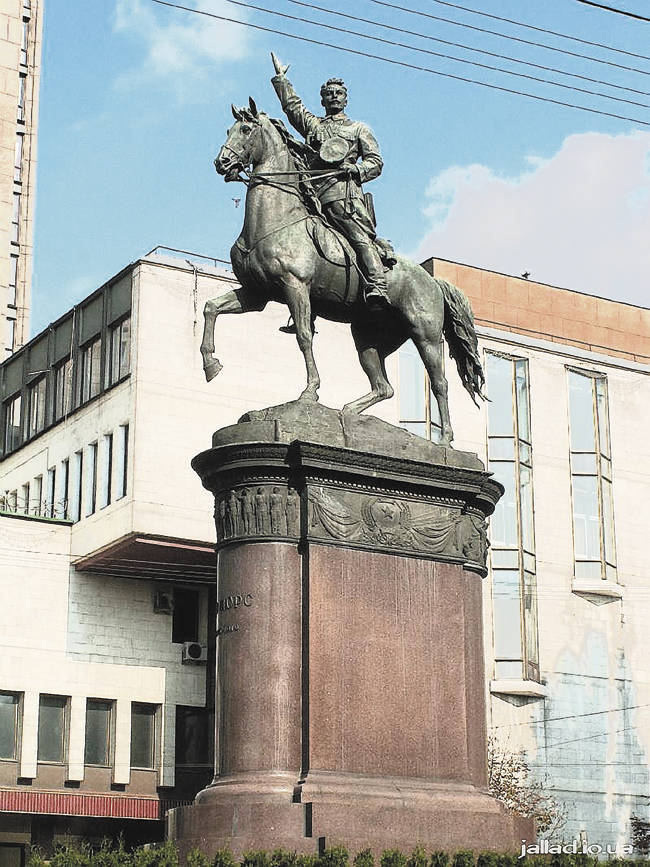
Let us turn to the official document: “At the first moment after removing the lid of the coffin, the general contours of the head of the corpse with the hairstyle characteristic of Shchors, the mustache and beard were clearly distinguishable. A trace was also clearly visible on the head, left by a gauze bandage in the form of a wide, falling strip running across the forehead and along the cheeks. Immediately after removing the coffin lid, in the eyes of those present, the characteristic features, due to the free access of air, began to change rapidly, turned into a shapeless mass of a uniform structure ... "
Forensic experts have determined that the damage to the skull was “caused by a bullet from a rifled gunshot weapons". She entered the back of the head, and went out in the region of the crown. And here's the most important thing: "The shot was fired from close range, presumably 5-10 steps."
Consequently, Shchors was shot by someone who was nearby, and not at all by Petliura's machine-gunner, as many times it was reproduced in “canonical” books and a feature film. Is ... someone your own?
OAK AND KVYATEK
Now is the time to turn to the memories of eyewitnesses of that fight. In 1935, the world saw the Legendary Commander collection. Among the memories of relatives and friends is the testimony of a man in whose hands Shchors died, Ivan Dubovoy, assistant commander of the Kiev military district.
He says: “I remember August of the year 1919. I was appointed deputy commander of the Shchors division. It was under Korosten. Then it was the only springboard in Ukraine, where the red banner fluttered victoriously. We were
surrounded by enemies: on the one hand, the Galician-Petliura troops, on the other, Denikinians, on the third, the White Poles squeezed the tighter and tighter ring around the division, which by this time had been numbered 44. ”
And further: “Shchors and I arrived at the Bogun Bongardt Brigade. In the regiment, commanded by Comrade. Kvyatek (now Commander Commissar of the 17 Corps). We drove up to the village of Beloshitsy, where our fighters were in chains, preparing for the offensive. ”
“The enemy opened a strong machine-gun fire,” says Dubovaya, “and especially, I remember, one machine gun showed“ dashing ”at the railway booth. This machine gun also made us lie down, because the bullets literally dug the ground around us.
When we lay down, Shchors turned his head to me and said.
- Vanya, look how the machine gunner shoots accurately.
After that Shchors took the binoculars and began to look where the machine-gun fire came from. But after a moment, the binoculars fell out of the hands of Shchors, fell to the ground, the head of Shchors too. I called him:
- Nikolay!
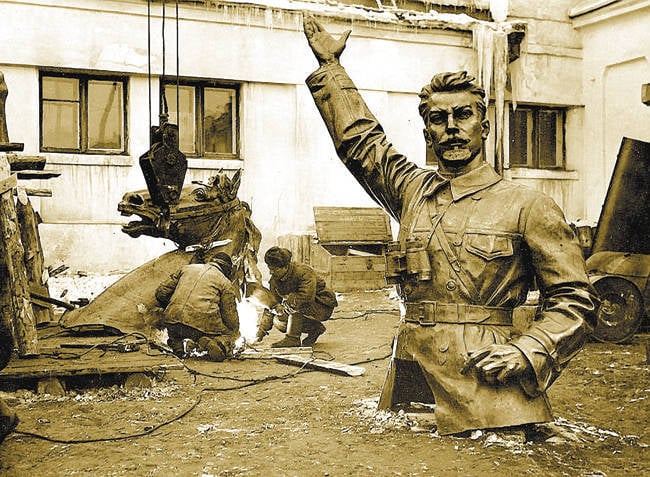
But he did not respond. Then I crawled over to him and began to look. I see blood on the back of my head appeared. I took off his cap - the bullet hit the left temple and went to the back of the head. Fifteen minutes later Shchors, without regaining consciousness, died in my arms. ”
So, we see that the person in whose hands Shchors died, deliberately lying, misleading readers about the direction of the bullet's flight. Such a free interpretation of the facts makes you wonder.
The commander of 2 rank Ivan Dubovaya himself was shot in 1937 on the then standard charge of “treason”. The collection “The Legendary Chief Officer” was on the shelf of the special storage facility.
During the investigation, Dubovoy made a shocking confession, stating that the death of Shchors was his own work. Explaining the motives of the crime, he said that the commander had killed the person out of personal hatred and the desire to take his place himself.
The interrogation report from 3 December 1937 of the year says: “When Shchors turned his head to me and said this phrase (“ good machine gun from the Galicians, damn it ”), I shot him in the head from the gun and hit his temple. The then commander of the 388 Infantry Regiment of Kvyatek, who was lying next to Shchors, shouted: “Shchors were killed!” I crawled up to Shchors, and he in my arms, in 10-15 minutes, without regaining consciousness, died. ”
In addition to acknowledging Dubov himself, 14 of March 1938 made similar accusations against him to Kazimir Kvyatek, who wrote a statement from the Lefortovo prison addressed to People's Commissar of Internal Affairs Yezhov, where he indicated that he directly suspects Dubrov of the murder of Shchors.
Despite such revelations, no one filed charges of killing Shchors to Dubovoy. Moreover, the recognition had no consequences whatsoever and for many years lay on the shelves of the state security archives.
MORE ONE CANDIDATE
Researcher Nikolai Zenkovich, one of the largest specialists in historical riddles, spent a lot of time searching for the printed works of the former commander of the Bogunsky regiment. No trace. And suddenly, when it seemed that the last hope had disappeared, in the filing of the Ukrainian newspaper “Communist” for March 1935, the stubborn historian found a small note signed by the person sought.
So, Kazimir Kvyatek writes: “At dawn, on August 30, the enemy launched an attack on the left flank of the front, embracing Korosten ... The headquarters of the Bogun regiment was then in Mogilny. I left on the left flank in the village Beloshitsu. On the phone I was warned that the regimental headquarters in the village. Grave profits beginning comrade. Shchors, his deputy comrade. Oak and authorized by the Revolutionary Military Council of the 12 Army comrade. Tanhil-Tanhilevich. I reported on the phone the situation ... After a while, Comrade. Shchors and his entourage came to our front line ... We lay down. Tov. Shchors raised his head, picked up his binoculars to watch. At that moment, an enemy bullet hit him ... ”
In March 1989, the newspaper Radyanska Ukraina directly pointed to the criminal who shot Shchors with the approval of the Revolutionary Military Council of the 12 Army. The authors of the publication managed to get some information about it. Tanhil-Tanhilevich Pavel Samuilovich. Twenty six years. Originally from Odessa. Dandy. He graduated from high school. Quite tolerably expressed in French and in German. In the summer of 1919, he became the political inspector of the Revolutionary Military Council of the 12 Army.
Two months after the death of Shchors, he hastily disappears from Ukraine and is announced on the Southern Front, already as a senior censor-controller of the Military Censorship Section of the Revolutionary Military Council of the 10 Army.
The investigation was continued by the Rabochaya Gazeta published in Kiev. She published a really sensational material - excerpts from the memoirs of Major-General Sergei Ivanovich Petrikovsky (Petrenko) written back in 1962, but not printed for reasons of Soviet censorship. At the time of the death of Shchors, he commanded the Separate Cavalry Brigade of the 44 Army - and also, it turns out, accompanied the commander to the front.
“August 30,” says the general, “Shchors, Dubovoy, I, and the political inspector from the 12 Army, gathered to go to the units along the front. The Shchors car seems to have been repaired. We decided to use my ... We left 30 in the afternoon. Kasso (driver) and I are in front, Schors, Dubovoy and political inspector in the back seat. At the site of the Bogun brigade Shchors decided to stay. We agreed that I was going to Ushomir by car and from there I sent a car to pick them up. And then they will come to Ushomir to a cavalry brigade and take me back to Korosten.
When I arrived in Ushomir, I sent a car for them, but a few minutes later, on the field telephone, they said that Shchors was killed ... I rode astride Korosten, where he was taken.
The driver Kasso drove already dead Shchors to Korosten. In addition to Oak and the nurse, a lot of all people were attached to the car, obviously - commanders and fighters.
Shchorsa I saw in his car. He was lying on the couch, his head was bandaged helplessly. Oak was somehow in my car. He gave the impression of a person excited, repeated several times how Shchors died, thought, looked at the window of the car for a long time. His behavior then seemed to me normal for a man, next to whom his comrade was suddenly killed. Only one thing didn’t like it ... Oak-tree several times began to tell, trying to give a humorous tint to his story, as he heard the words of the Red Armyman lying on the right: "What bastard is it from a livert firing? .." The gun-case fell on the head of the Red Army man. A political inspector shot Browning, according to Duboviy. Even parting for the night, he told me again how a political inspector shot at an enemy at such a long distance ... ”
The general is convinced that the shot, which killed Shchors, came after the Red artillery smashed the railway booth, behind which it was located.
“When the enemy machine gun was fired,” says the general, “on Shchors they went to Dubovoy, on the one hand, and on the other, the political inspector. Who is on the right and who is on the left - I have not yet installed, but this is no longer significant. I still think that the political inspector was shooting, not Dubova. But without the assistance of the Oak murder there could not be ... Only relying on the assistance of the authorities in the person of Deputy Shchors - Oak, on the support of the Revolutionary Military Council of the 12 Army, the criminal committed this terrorist act.
I think that Dubova became an unwitting accomplice, perhaps even believing that it was for the benefit of the revolution. How many such cases we know !!! I knew Dubovoy, and not only by the civil war. He seemed to me a honest man. But he seemed to me and weak-willed, without any special talent. He was nominated, and he wanted to be nominated. That's why I think he was made an accomplice. And he did not have the courage to prevent murder.
The dead Shchors bandaged his head right there on the battlefield, personally Dubova himself. When the nurse of the Bogunsky regiment Rozenblyum Anna Anatolyevna (now she lives in Moscow) offered to be treated more carefully, she was not allowed to Dubova. By order of the Shchors Oak, the body was sent for parting and burial without a medical examination ... ”
Obviously, Oakova could not have been unaware that the bullet “exit” opening is always larger than the “entrance” one. Therefore, apparently, and forbidden to remove the bandages.
A member of the RVS 12-th Army was Simon Aral, the confidant of Leo Trotsky. He twice wanted to remove the "indomitable guerrilla" and "the enemy of the regular troops", which Shchors was called, but he was afraid of the revolt of the Red Army.
After an inspection trip to Shchors, which lasted no more than three hours, Semyon Aralov appealed to Trotsky with a convincing request to find a new division chief - only not from the local ones, because the “Ukrainians” are one and all “with kulak sentiments”. In return encryption, the Demon Revolution ordered a strict purge and “refreshment” of the commanding staff. A conciliatory policy is unacceptable. Any measures are good. Need to start "with the head."
By all appearances, Aralov was jealous of the fulfillment of the instructions of his terrible master. In his manuscript “In Ukraine 40 years ago (1919),” he unwittingly let it slip: “Unfortunately, persistence in personal behavior led Shchors to a premature death.”
Yes, about the discipline. During the reorganization of the armed forces of Red Ukraine, the Shchors division was supposed to be redeployed to the Southern Front. In particular, Podvoisky, People's Commissar of the Republic for military and naval affairs, insisted on this. Justifying his proposal in a memo addressed to the chairman of the SNK Ulyanov-Lenin from 15 June, he stressed that, having visited parts of the 1 Army, he finds the Shchors division, which includes the most harmonious regiments, the only fighting on this front.
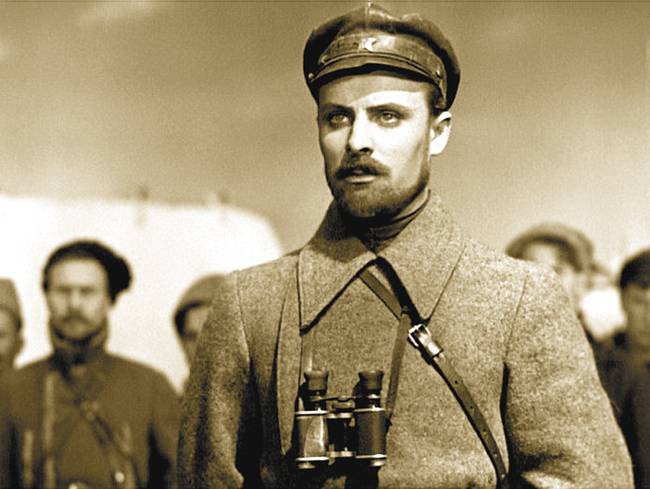
In the Soviet Union, five monuments of the legendary priest were erected and the same number of open museums of Shchors. Comrade Stalin called him “Ukrainian Chapaev,” director Alexander Dovzhenko dedicated a film to him, the writer Semyon Sklyarenko the trilogy “Went to Kiev”, and composer Boris Lyatoshynsky the “nominal” opera.
ORIGIN
However, the most undoubtedly well-known artistic embodiment of Shchors was the work of songwriter Mikhail Golodny (Mikhail Epshtein) “Song of the Shchors”. The people called her by the first lines: “A detachment was walking along the shore”.
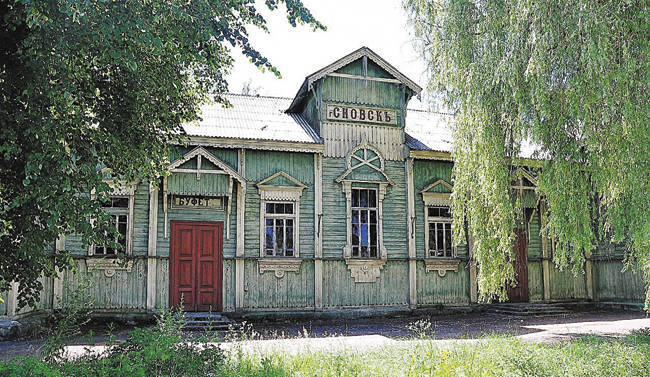
After the death of the Soviet Union, the pendulum swung in the other direction. It got to the point that in 1991 a single thick Moscow magazine asserted in all seriousness that there was no Shchors at all.
Say, the birth of the myth began with Stalin's famous meeting with artists in March 1935. It was then, at that meeting, the leader turned to Alexander Dovzhenko with the question: "Why does the Russian people have the hero Chapaev and a film about the hero, but the Ukrainian people do not have such a hero?".
Thus began the legend ...
Shel squad along the shore,
Walked from afar
Walked under the red banner
Commander of the regiment.
The head is bound,
Blood on the sleeve
Trail bloody spreads
On the wet grass.
"Whose lads will you be,
Who leads you into battle?
Who is under the red banner
Wounded goes? "
"We are sons of hind hands,
We are for a new world,
Shchors goes under the banner -
Red commander.
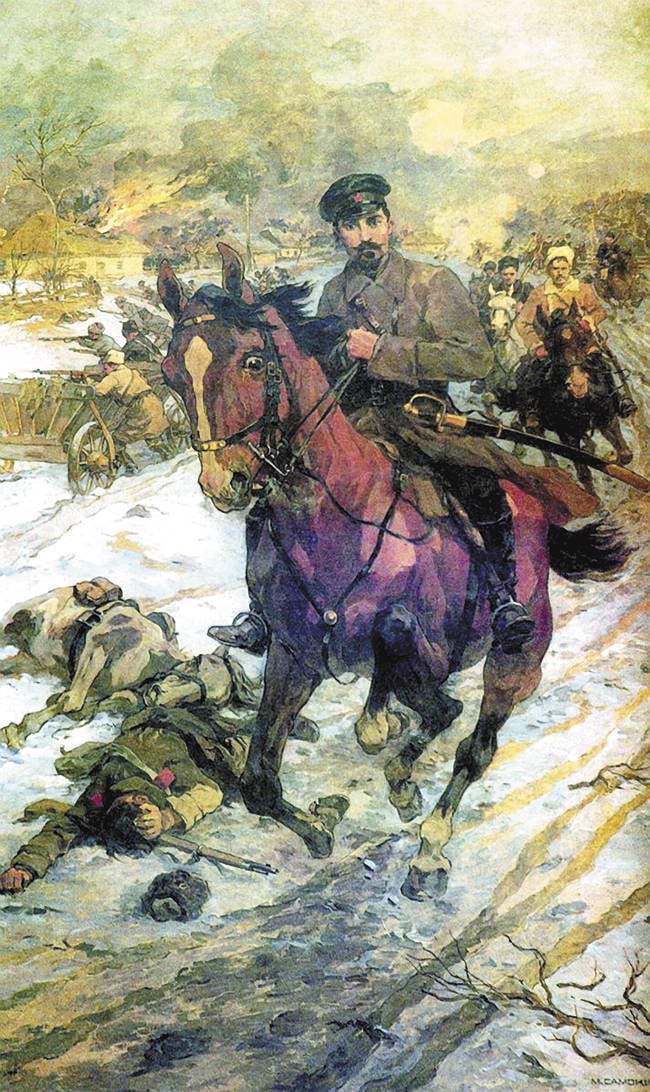
Shchors' father, Alexander Nikolaevich, was a native of Belarusian peasants. In search of a better life, he moved from Minsk province to the small Ukrainian village of Snovsk. From here he was taken to the imperial army.
Returning to Snovsk, Alexander Nikolayevich got a job at the local railway depot. In August, 1894, he married his countrywoman, Alexandra Mikhailovna Tabelchuk, and in the same year built his own house.
Shchors knew the Tablichuk family for a long time, since its head, Mikhail Tabelchuk, was in charge of the artel of Belarusians who worked in Chernihiv region. One time, Alexander Shchors was a member of it.
Nikolai Shchors, the future chief, quickly learned to read and write; at the age of six he already knew how to read and write tolerably well. In 1905, he entered the parochial school.
And a year later, in the Shchors family, great grief happened - being pregnant with the sixth child, the mother, Alexandra Mikhailovna, died from bleeding. It happened when she was in her small homeland, in Stolbtsy (modern Minsk region). There she was buried.
Half a year after the death of his wife, the head of the Shchors family entered marriage again. His chosen one was Maria Konstantinovna Podbelo. From this marriage, Nicholas had two stepbrothers, Gregory and Boris, and three half-sisters - Zinaida, Raisa and Lydia.
AND THE SEMINARIES WERE NOT!
In 1909, Nikolai graduated from school and the next year, together with his brother Konstantin, entered the Kiev military medical assistant school. Her pupils were on full state support.
Schors studied in good faith and four years later, in July 1914, he received a diploma of a medical assistant and the rights of a volunteer 2 class.
“The whole problem was that after leaving the school, Shchors was obliged to serve as a paramedic for at least three years,” reports ULECHAonline. - Shchors, we recall, graduated from college in 1914 year. At the same time, as stated in a number of sources, he, in order to avoid the mandatory three-year medical assistant service, decides to falsify and sends in his diploma (certificate) the date of completion of the medical assistant's school from 1914 to 1912 year, which gives him the right to get rid of the status already in 1915. volunteer.
The archives of the Uonech Museum have an electronic copy of this certificate, from which it really follows that Shchors enrolled in 15 school on August 1910 of the year and graduated in June on 1912 of the year. However, the “2” figure is somewhat unnatural, and it is very similar to the fact that it was actually shipped from the four. ”
As “authoritatively” stated in some sources, Shchors studied at the Poltava Teachers' Seminary - from September 1911 to March 1915. There is a clear discrepancy. So we can conclude: in the seminary, Shchors did not study, and the certificate of graduation was fake.
“In favor of this version,” writes UHECHAonline, “the fact that in August 1918 of the year Shchors, applying for admission to the medical faculty of Moscow University, among other papers, presented a certificate of graduation from the Poltava seminary, which, in contrast, from the certificate of graduation 4-nd classes of medical assistant, gave the right to enter the university. "
So this evidence, a copy of which is also available in the Uonech Museum, was obviously straightened by Shchors just for presentation to Moscow University.
WHOM YOU COTS WILL BE?
After his studies, Nikolay was assigned to the troops of the Vilna military district, which became front-line with the outbreak of the First World War. As part of the 3 of the Light Artillery Division, Shchors was sent under Vilna, where he was injured in one of the battles and sent for treatment.
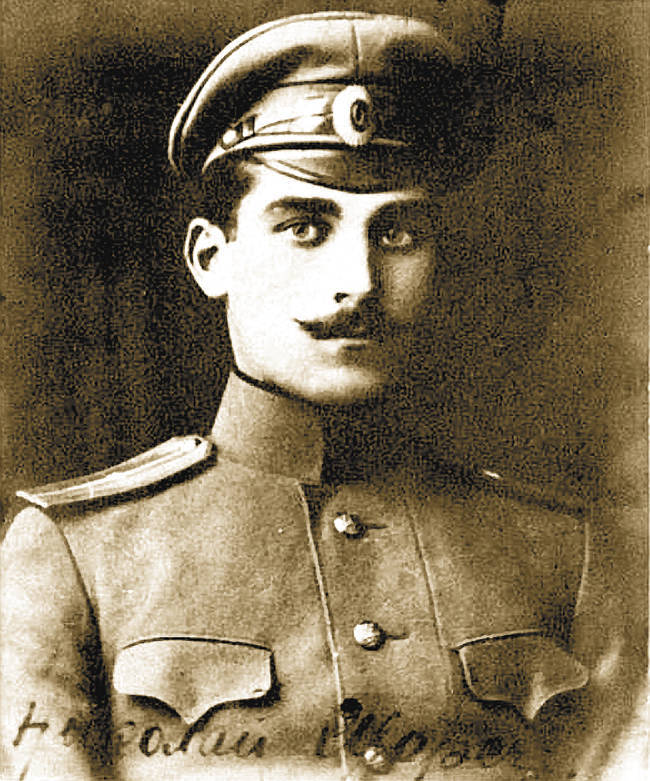
In 1915, Shchors was already among the cadets of the Vilna military school who were evacuated to Poltava, where, due to the military situation, they began to train non-commissioned officers and warrant officers under a shortened four-month program. In 1916, Shchors successfully completed a military school course and, with the rank of warrant officer, went to the rear forces in Simbirsk.
In the autumn of 1916, the young officer was transferred to service in the 335-th Anapa regiment of the 84-th Infantry Division of the South-Western Front, where Shors rose to the rank of second lieutenant.
At the end of 1917, a short military career ended abruptly. Health failed - Shchors became ill (almost an open form of tuberculosis) and after a short treatment in Simferopol on December 30 of 1917, he was commissioned due to his unsuitability for further service.
Being out of work, Nikolay Shchors at the end of 1917, decides to return home. The estimated time of his appearance in Snovsk is January of the eighteenth year. By this time, in a country that had fallen apart, there had been tremendous changes. In Ukraine, at the same time, an independent Ukrainian People's Republic was proclaimed.
Around the spring of 1918, the period of the creation of the combat unit, headed by Nikolai Schors, begins. In the history of the civil war, in its red annals, it entered under the name of the Bogunsky regiment.
1 August 1919 of the year under Exactly, during the insurrection, under obscure circumstances, the Shchorsian Timofey Chernyak, commander of the Novgorod-Seversk brigade, was killed.
21 August of the same year, “indomitable dad” Vasily Bozhenko, commander of the Tarashchansky brigade, died suddenly in Zhytomyr. It is alleged that he was poisoned - according to the official version, he died of pneumonia.
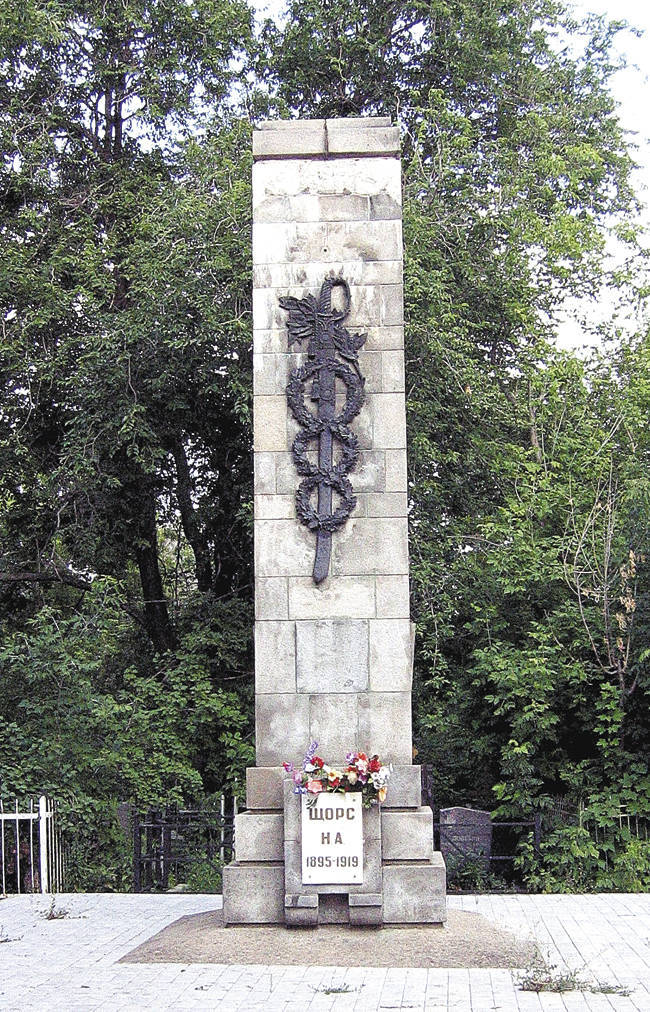
Both commanders were the closest associates of Nikolai Shchors.
Until 1935, his name was not widely known; even the Great Soviet Encyclopedia of the first edition did not mention it. In February, 1935, handing Alexander Dovzhenko at the meeting of the Presidium of the All-Russian Central Executive Committee the Order of Lenin, Stalin suggested that the director make a film about “Ukrainian Chapaev”.
- Shchorsa you know?
- Yes.
- Think of it.
Soon the personal artistic and political order was masterfully executed. The main role in the film was brilliantly played by Evgeny Samoilov.
Later, several books, songs, even an opera were written about Shchors. Schools, streets, villages and even a city were named after him. As mentioned at the beginning, Matvey Blanter and Mikhail Golodny in the same 1935 year wrote the famous “Song of the Shchors”.
In hunger and cold
His life has passed,
But no wonder spilled
His blood was.
Over the cordon thrown
Fierce enemy
Tempered youth
Honor is dear to us.
Silence near the shore
Silent voices
The sun is going down,
Dew is falling.
Famously racing cavalry,
The sound of hooves is heard,
Shchors banner red
It makes a noise in the wind.
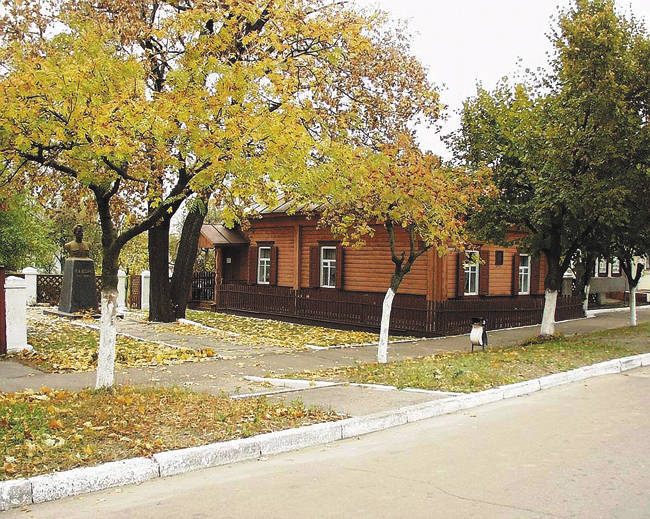
Like many field commanders, Nikolay Shchors was only a “bargaining chip” in the hands of the powerful. He died at the hands of those for whom his own ambitions and political goals were more important than human lives.
As the former member of the Revolutionary Military Council of the Ukrainian Front, E. Shchadenko, said, “Shchors could be torn away from the division, in whose consciousness it was rooted, only enemies could. And they tore it off. ” However, the truth about the death of Nikolai Shchors still made its way.
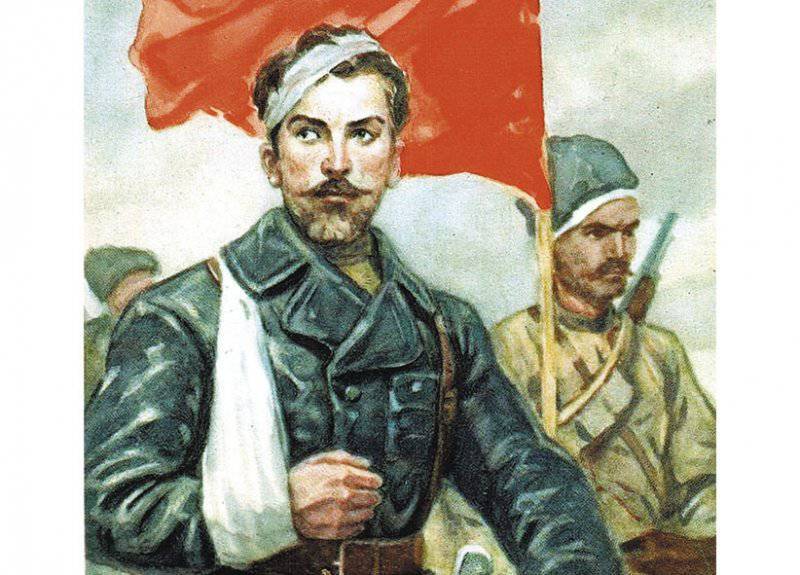
Information